8: The Baroque Period in Italy and Spain
( \newcommand{\kernel}{\mathrm{null}\,}\)
Introduction
Along comes a painter who has the strength and talent to defy the normal conventions of Roman Catholic religious painting styles. Around 1600, he approaches the painting of religious subjects as if they take place in his time, and on the streets and taverns of Rome. He doesn't paint Cupids, clouds, the saints, Mary, and Jesus in heavenly settings. Instead, he places Jesus and the apostles in familiar surroundings that the congregants will recognize and understand, bringing the teachings of Christ in a more accessible manner. He was widely criticized for his realistic approach to sacred images, however in a statement that pushes back at the overly sentimental religious paintings, he comments that he doesn't include angels in his paintings since he has never seen an actual angel. This practical approach to painting religious subjects was refreshing to his supporters and patrons. The painter who creates this new style of religious painting is Caravaggio. The time when he begins this new style is right around 1600.
It is believed that Caravaggio painted directly on his canvases without any underlying drawings or extensive preliminary. work. He uses a modified chiaroscuro technique that was developed by Da Vinci, but he pushes this technique to create higher a contrast of values. We call this technique tenebrism. We also see the fascination with using mathematical linear perspective to create the illusion of deep spaces in two- dimensions now gives way to an interest in dramatic representations and the inclusion of the viewer in the painting. Caravaggio does this by limiting the depth within the painting by creating a dark backdrop that may extend 10 to 15 feet rather than a landscape background that may extend for miles ss we would see in many Renaissance and late Renaissance paintings. The visual space in the paintings moves out towards the viewer, often with foreshortened limbs of the figure reaching out into our space. There is an emphasis on the theatrical that we witness in these paintings that separate them from the beauty and balance of the earlier Renaissance works. No longer is the goal to merely create balance and beauty, but now the emphasis is on drama, storytelling, and a connection with the congregants viewing the work. In Caravaggio's work, we see the essential elements of the Baroque art experience which are dramatic lighting, theatricality, and an elevated sense of storytelling. This all dovetails beautifully with the requirements and purpose of the Counter Reformation.
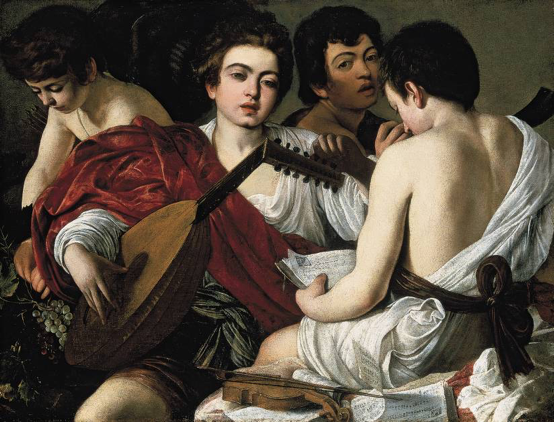
Caravaggio 1595
Some of Caravaggio’s early works include homoerotic subjects painted for his patron Cardinal del Monte. In this genre painting, Caravaggio paints himself into the background to the upper right. The gaze of the young boys looking out to the viewer is highly suggestive. The setting is more fitting for a gathering of boys in ancient Rome and includes references to the muses.
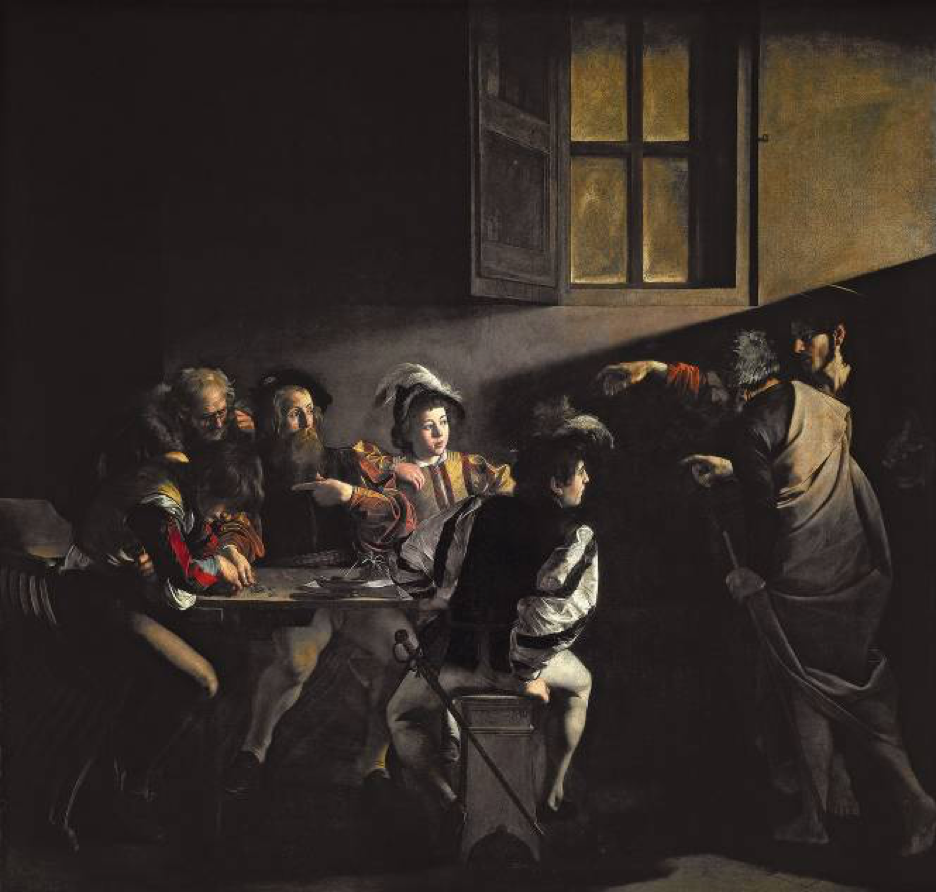
The Calling of Saint Matthew, Carravagio 1601
The Calling of Saint Matthew is part of a three-painting installation at the Contarelli Chapel in Rome. Here we see Caravaggio’s painting style fully expressed. The setting includes a darkened tavern with tax monies being counted by Matthew and his cohorts. They are armed and dressed in the costumes of the early 1600s in Rome. Jesus reaches out to Matthew with the hand of Adam painted by Michelangelo on the Sistine Chapel ceiling. Matthew responds by pointing to himself in a gesture that suggests he is questioning if he is the chosen one. In the Gospel of Luke 5:27-28, it is told that he immediately leaves his position of tax collector and follows Jesus. The essence of Jesus’ teachings is expressed in this painting. Jesus came to bring light to the darkness, and in this painting, Matthew sits in a darkened room where it is implied, he may skim a little off the top of the taxes he collects. Jesus arrives with the light of Truth and God’s presence moving into the darkened space. Jesus explains to the religious leaders that he came to bring light, hope, and salvation to sinners, whether Jew or Gentile. He was not interested in the trappings of power and ceremony as were the hypocritical Pharisees. Caravaggio would certainly understand this message from Jesus as he considered himself a sinner. In a brawl, Caravaggio will kill a man and be banished from Rome. He travels to Spain where several painters will begin applying his techniques in their paintings.
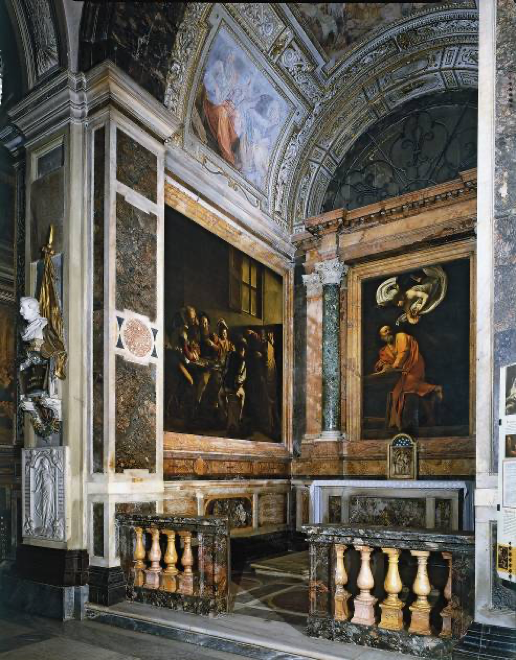
Contarelli Chapel, Rome Caravaggio 1599-1600
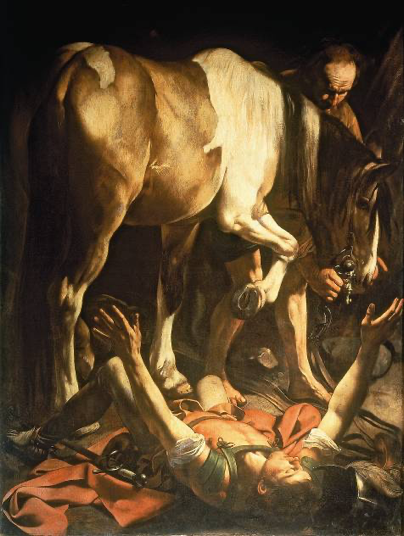
The Conversion of Saint Paul, Caravaggio 1601
Saul was a learned Jew living in the time of Jesus’ ministry. After Jesus was crucified, he sought and obtained a letter of permission to go after Jesus’ followers. He travels on the road to Damascus to capture and imprison the followers of Jesus who had fled to that town after fleeing Jerusalem. As he neared Damascus on his journey, suddenly a light from heaven flashed around him. He fell to the ground and heard a voice say to him, “Saul, Saul, why do you persecute me?” “Who are you Lord?” Saul asked. “I am Jesus, whom you are persecuting,” he replied. Acts 1:1-5
This event leads Saul to become the most important cornerstone in the spreading of Christianity throughout the Roman Empire and eventually, the world. Saul will become Saint Paul and join the apostles and followers of Christ in Damascus. Caravaggio creates a dramatic scene with the light, once again, becoming a symbol of Jesus, the light of the world appearing to Saul. Saul’s arms reach out to us, the congregation in the Contarelli Chapel who come up and kneel at the alter and pray, placing us in this pivotal moment in the history of Christianity. The horse prevents us from moving deeper into the space and the visual movement within the painting, such as the horse’s head, the man holding the halter, and the light source, all work to direct our eyes to Saul (Saint Paul).
https://www.youtube.com/watch?v=1KcdgFxmnb4
https://www.youtube.com/watch?v=CqfHNi8HptQ
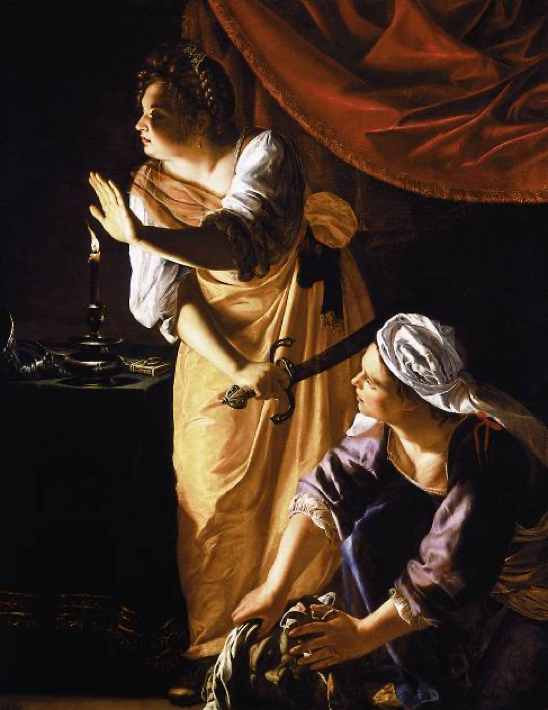
Judith and Her Maidservant with the Head of Holofernes, Artemisia Gentileschi
Artemisia Gentileschi is a female painter in a male-dominated world. She follows in the painting style of Caravaggio and creates paintings embodying the essential Baroque attributes. Her paintings are often filled with theatricality, tenebrism, and Counter Reformation themes. Judith and Her Maidservant with the Head of Holofernes covers a subject painted by several painters including Caravaggio himself. However, her painting is right after Holofernes’ head has been separated from his body and is being stuffed into a sack by Judith’s maidservant. The subject is a delicate one since the suggestion that Judith offered sex to Holofernes to gain access to his tent to carry out her murderous deed is implied. Even though her heroic act saves her people, the stigma may still exist. Artemisia presents Judith as a strong female heroine taking the battle to the enemy in a dramatic representation. It is a thrilling moment of theater that she paints when Judith pauses after hearing someone outside the tent, and holds her hand over the candle to focus her eyes in the direction of the sound. Very dramatic and brilliantly executed with dramatic lighting and composition.
Artemisia accused her teacher of raping her. She had the support of her father and proceeded to go through the judicial system of Rome at the time. Although she did not receive the complete guilty charge she sought, the accused was banished from Rome. This speaks volumes to the strength of her character and the power she wielded as a talented painter. Italy, for the most part, highly valued talented painters, sculptors, and architects over the centuries, whereas Spain did not look as highly on painters and artists. Her pursuit of justice in Spain may have been a very different experience.
https://www.youtube.com/watch?v=cNsg6RnlJtI
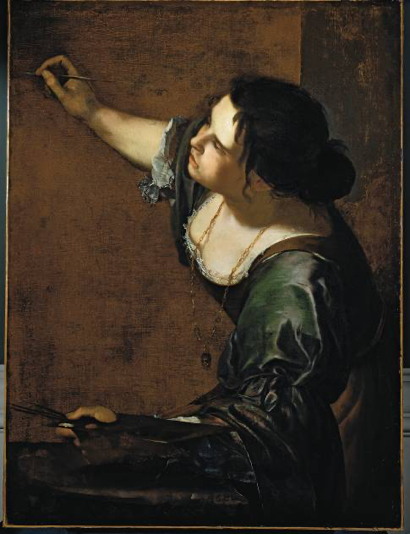
Self Portrait as the Allegory of Painting, Gentileschi
In her self-portrait, Artemisia follows the literature that describes the muse of painting as having disheveled hair, a dress, and necklace. It is a strong statement. Well-executed showing her talents go beyond religious paintings.
https://www.youtube.com/watch?v=vpEkhH6AC0w
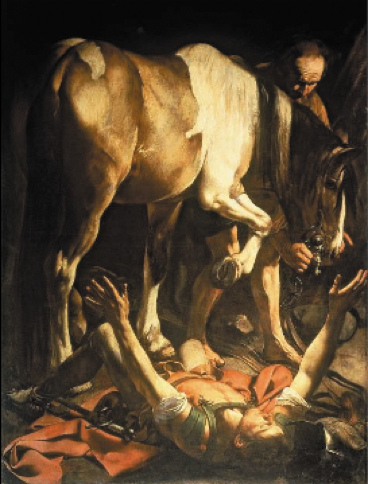
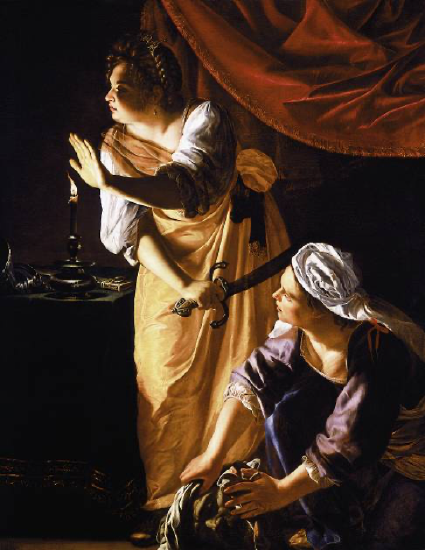
We see the similarities between the painting styles of Caravaggio and Gentileschi in the two paintings above. Both use compositions that engage the viewers, dramatic lighting, and shallow spaces where forms come out from the picture plane.
https://www.youtube.com/watch?v=qSnzm8-9t84
https://www.youtube.com/watch?v=AKxGdn9iA_0
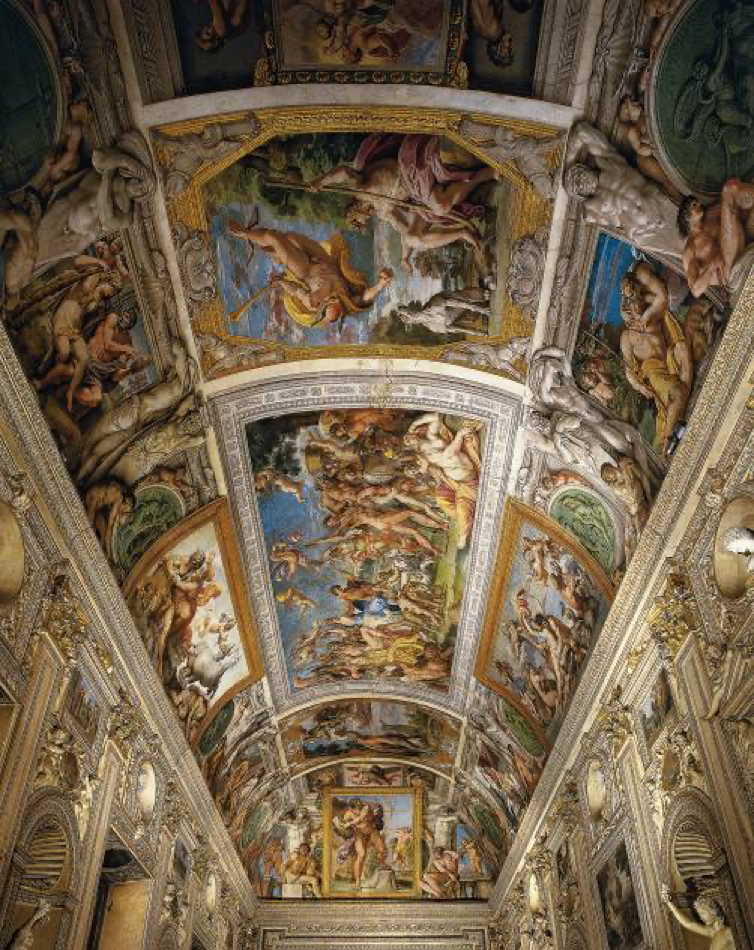
Loves of the Gods, Palazzo Farnese, Rome Annibale Carracci 1597-1601
https://www.wmf.org/project/carracci-gallery-palazzo-farnese
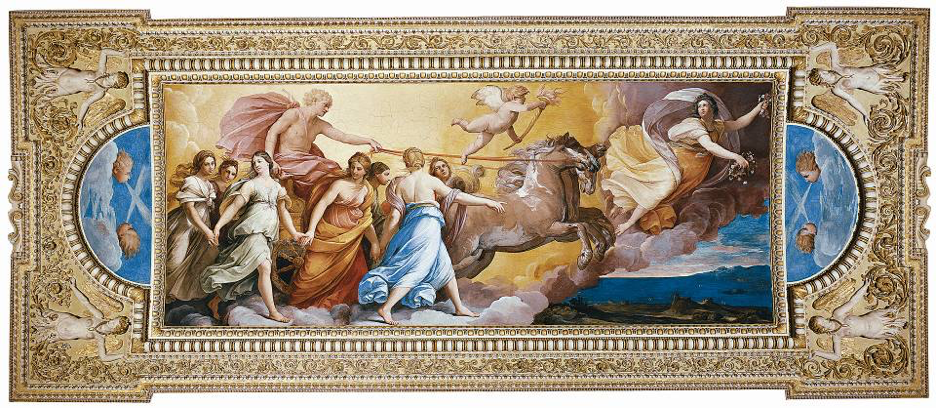
Aurora, Casino dell’Aurora Guido Reni 1613
Reni paints a beautiful fresco in the tradition of Raphael. The color pallet and painted figures with flowing gowns and dresses celebrate the pagan narrative in a timeless sublime work. It is delicately painted with movement, and a wonderful golden glow from the rising sun moving toward the darkened sky that includes the complementary color of violet to the right side of the painting.
https://www.getty.edu/art/collection/object/1046EX
https://www.youtube.com/watch?v=xLJmEOZm2Ss
https://www.youtube.com/watch?v=xEQseEvD_iI
https://www.youtube.com/watch?v=A8zXSNAscmg

Triumph in the Name of Jesus, Gesù, Rome Giovanni Battista Gaulli 1672-1679
https://artmuseum.princeton.edu/collections/objects/45004
https://smarthistory.org/il-gesu-rome/
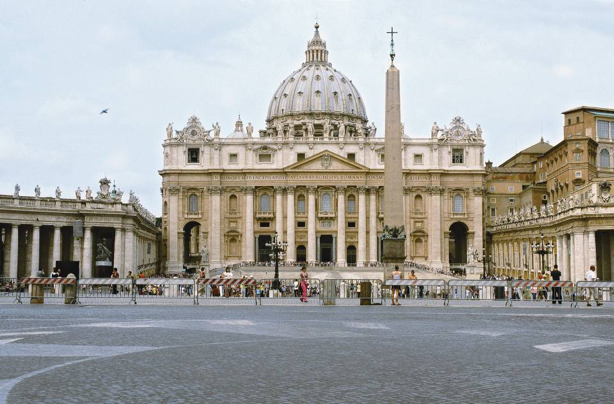
Façade of St. Peter’s, Rome Carlo Maderno 1607-1612
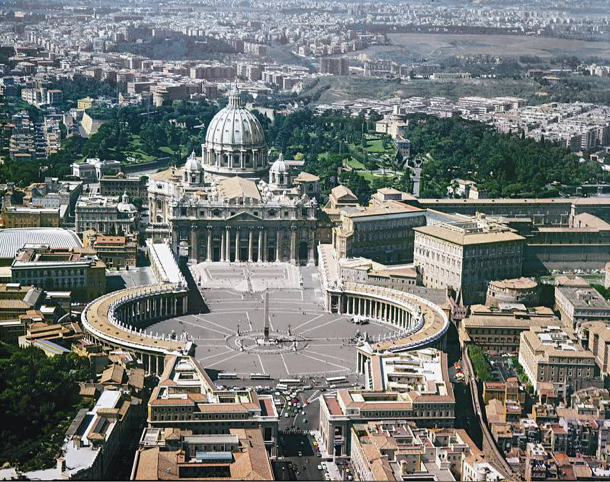
Aerial view of St. Pater’s, Rome, colonnade by Bernini
Bernini is an artist who creates religious works during the Counter Reformation movement of the Roman Catholic church. His architectural design for the colonnade symbolizes the arms of the church reaching out to the world to come back and be embraced by a caring and loving institution. It is massive in size and scale and guides the faithful to the façade of Saint Peter’s church. Bernini will be instrumental in reviving Rome as the central cultural hub of Europe at this time. He will help re-design the abandoned Roman fountains and see that they are once again functional. He also works on major religious installations with mystical themes supporting the Counter Reformation narrative.
https://www.youtube.com/watch?v=D0cV92kg6DQ

Baldacchino, St. Pater’s, Rome Bernini 1624-1633
Bernini works closely with the heads of the Catholic church on many innovative projects in and around Rome. One such project is the Baldacchino, a sculptural four-columned bronze structure designed to create a visual focal point over Saint Peter’s tomb at the crossing of the transepts and nave. It is massive in size and forms a canopy over the tomb. Nearly 100 feet high, the composite structure is a perfect Baroque statement full of imagination, energy, and lavish adornments. Images related to the Pope Urban VIII are included in the design as well.
https://www.youtube.com/watch?v=EFsaaK1w2Ao
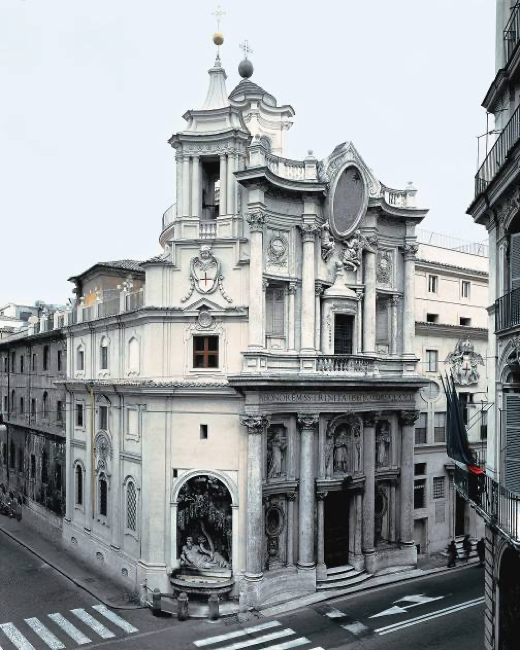

Façade, San Carlo alle Quattro Fontane, Rome Francesco Borromini 1638-1640
Francesco Borromini created architectural designs that were forward-thinking, complex, at times asymmetrical, and radical. He certainly had his critics since his work was unconventional, but he also had designers from distant lands coming to study his work firsthand. He treats the shapes and surfaces of his designs as if they are elastic and malleable. We can see how he pushed shapes inward creating concave spaces, while also pulling forms out to create a juxtaposed convex form. These dynamic qualities can be seen in the facades and domes. Just look at his treatment of domes. He creatively pulls on two sides of the circular dome to create an elliptical shape with complex textural forms made up of geometric shapes. Using the most efficient geometric shape, the hexagon, as well as octagons and crosses he designs a most unique interior surface for the dome at San Carlo alle Quattro Fontane. Entering through the unique double temple doorway of the façade, the visitor will be surprised to see such a beautiful dome in the building’s interior. Having to design a corner building was a challenge and his solution was too radical for some, and for others was sheer brilliance. Unfortunately, Borromini will commit suicide due to his struggles with unsuccessfully treated mental illness.
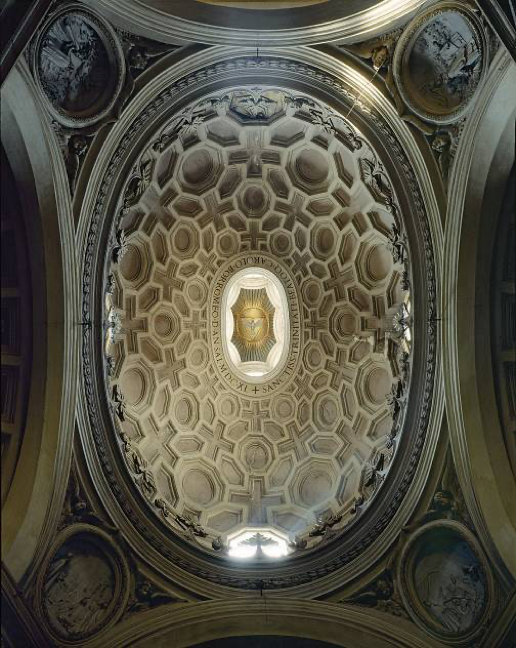
Dome of San Carlo alle Quattro Fontane, Borromini 1665-1667
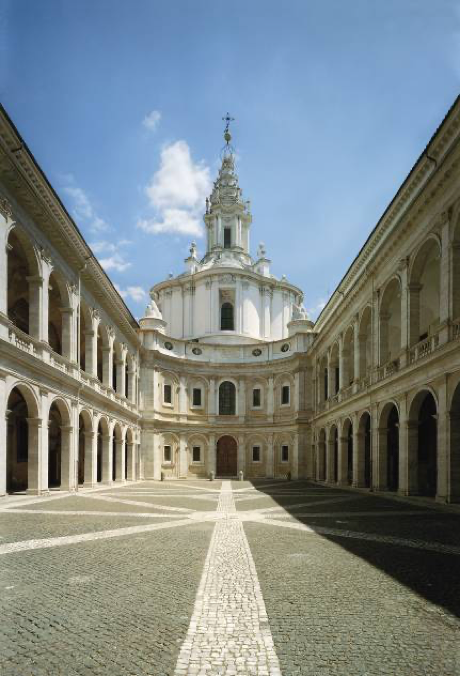
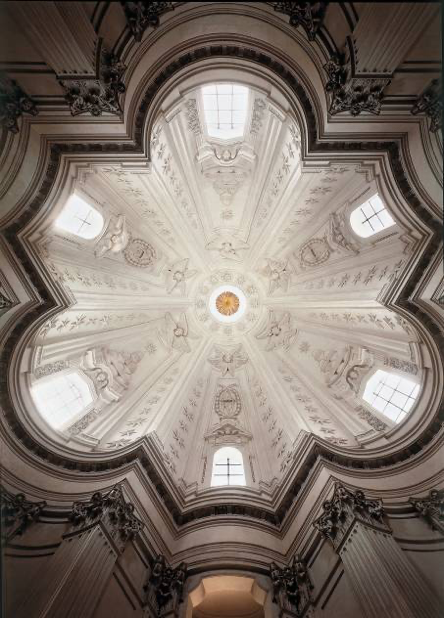
Exterior and dome Sant’Ivo, Rome Borromini 1642

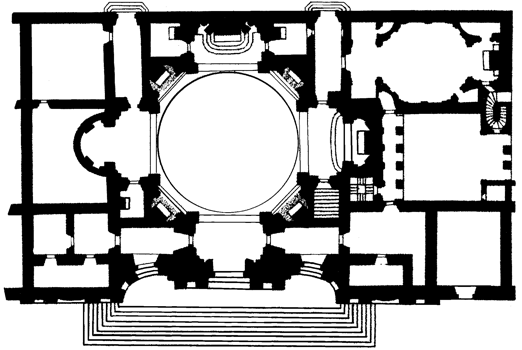
Sant’Agnese in Piazzo Navona, Rome Borromini 1653-1663
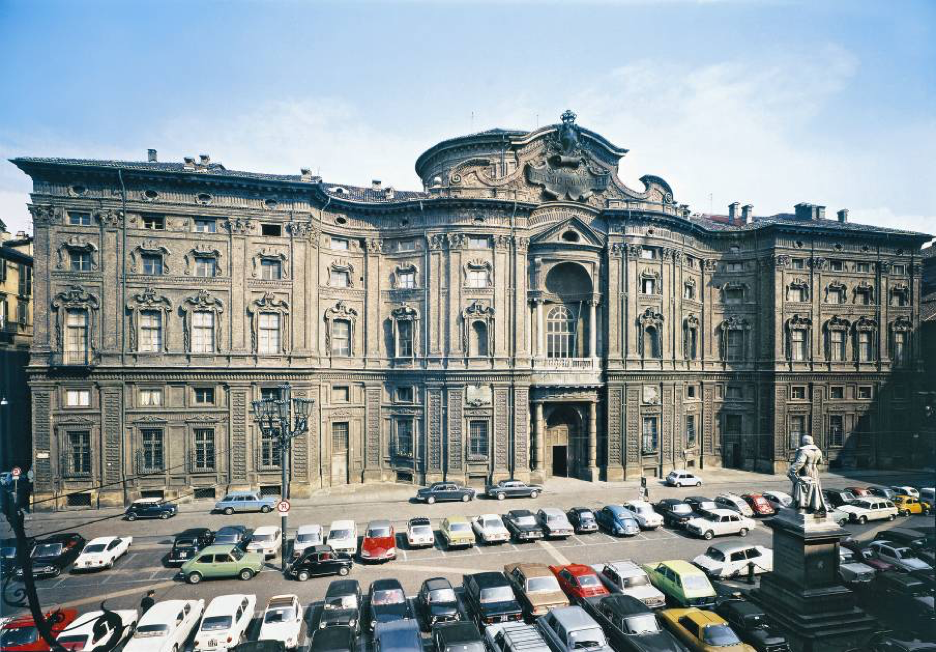
Façade of Palazzo Carignaro, Turin Guarino Guarini 1679
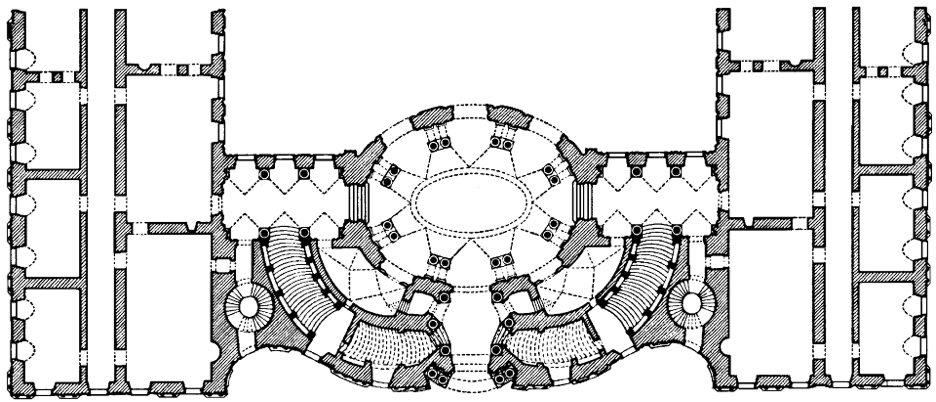
Plan of Palazzo Carignaro, Turin Guarino Guarini 1679
Guarini continue the creative designs of Borromini with the impressive Façade of Palazzo Carignaro. Bringing in elements of texture and the push and pull elasticity in Borromini’s designs, the façade is regal and impressive. We begin to see ornamentation and elaborate carvings that will soon be hallmark features of the Rococo period, while the adherence to strictly ancient classical architectural orders are fading away. The double temple façade of San Carlo alle Quattro Fontane is now modified into an elaborate arched balcony and the entryway below. A magnificent dome is the main feature when entering the Chapel of the Holy Shroud and is replete with new geometric shapes of stars, crosses, and hexagons.
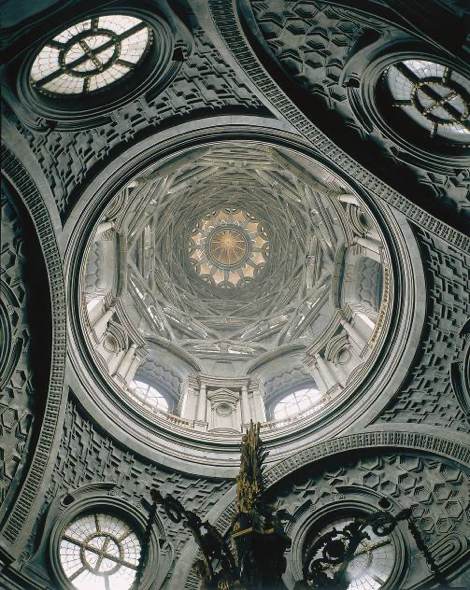
Dome of the Chapel of the Holy Shroud, Turin Cathedral, Guari 1668-1694
https://www.youtube.com/watch?v=_UAtY4Uiuoo
Bernini has a unique position as the primary artist of the Vatican and the successor in sculpture to Michelangelo. We can compare his position with that of Raphael who also had a quite successful relationship with the pope during his tenure as chief artist to the Vatican. Bernini was responsible for major works in and around Rome to further the ideals of the Counter Reformation. He was assigned to rehabilitate the fountains, and to unify and create a unique gathering space in front of Saint Peter’s. Creating a monumental colonnade that represents the two arms of Saint Peter’s symbolically reaching out to the faithful encloses Saint Peter’s square in elegant fashion. He also sculpts another image of David in the new style of the Baroque. His David includes his own determined grimace as a self-portrait of sorts. Donatello created a sensual David, Michelangelo a classical and athletic David, and Bernini sculpts a David in action coiled to throw the lethal stone using his sling.
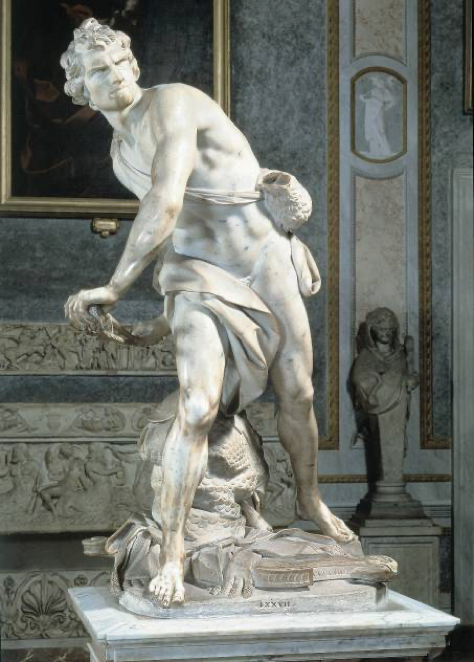
David, Bernini 1623
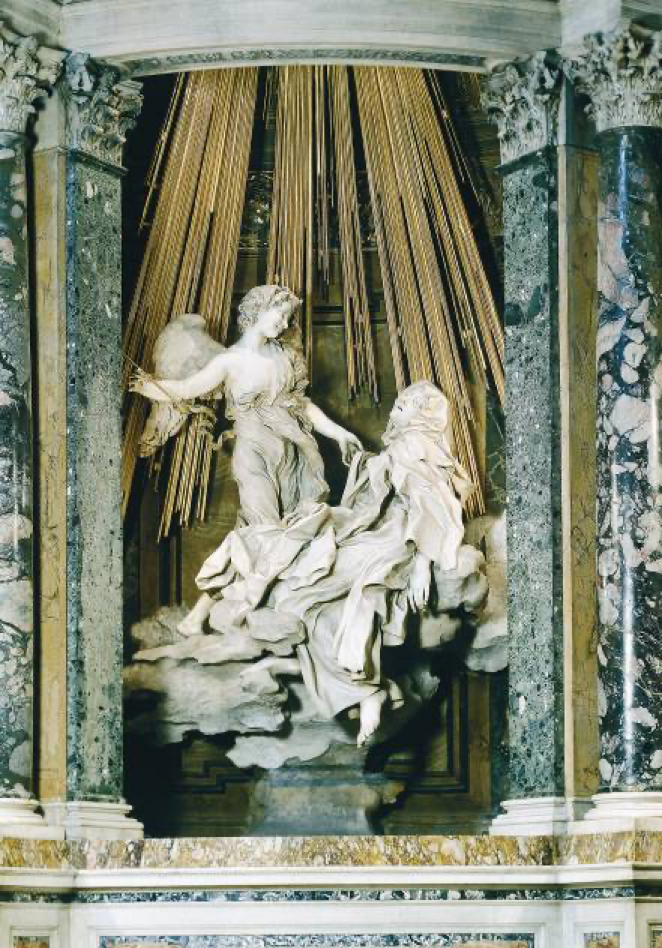
The Ecstasy of St. Teresa, Bernini 1645-1652
Bernini creates theatrical and dramatic sculptures using a variety of materials and techniques. With emphasis on Counter Reformation messages, he creates a sensual and mystical arrangement with The Ecstasy of St. Teresa. Saint Teresa, in her writings, explicitly recalls her spiritual interactions with heavenly beings.
https://www.youtube.com/watch?v=PhBwlI90n4U
The terra cotta head of Saint Jerome provides insight into the sculpting style of Bernini. In this study, Bernini seeks to create the emotional expression in the more easily manipulated clay that he’ll later sculpt in marble.
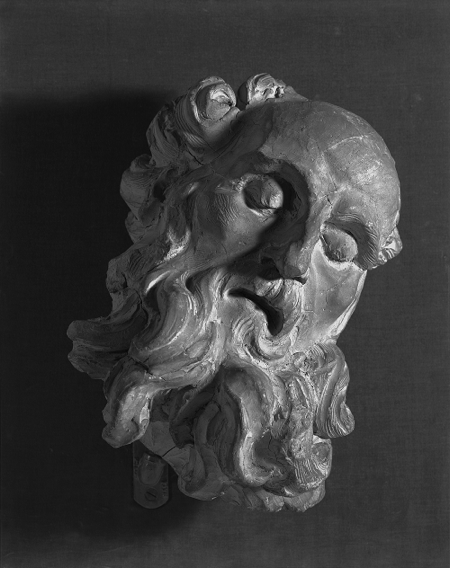
Head of St. Jerome, Bernini 1661
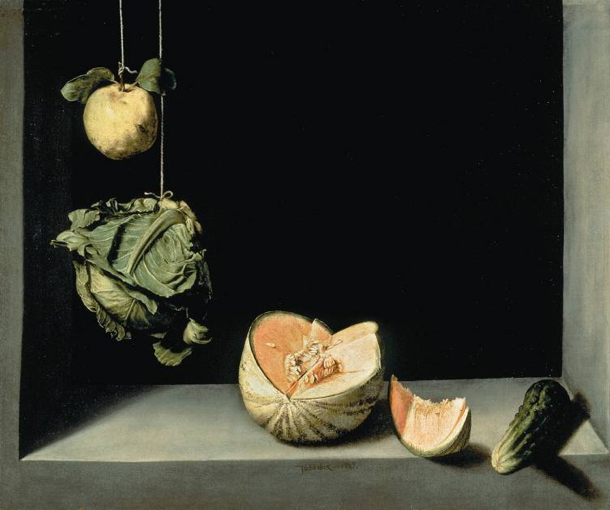
Quince, Cabbage, Melon, Cucumber, Juan Sanchez Cotán 1602
https://www.youtube.com/watch?v=-ZsAwhgM1wc
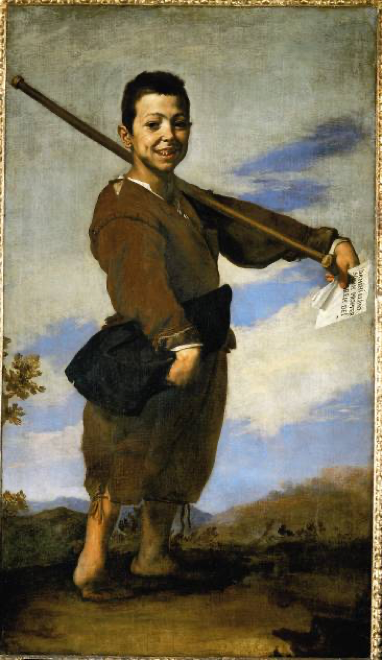
The Club-Footed Boy, Jusepe Ribera 1642
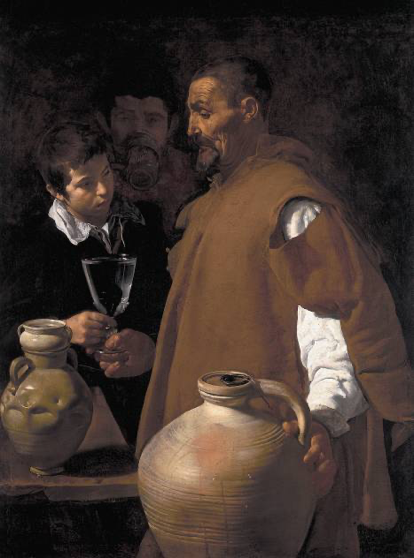
The Water Carrier of Seville, Diego Velázquez 1619
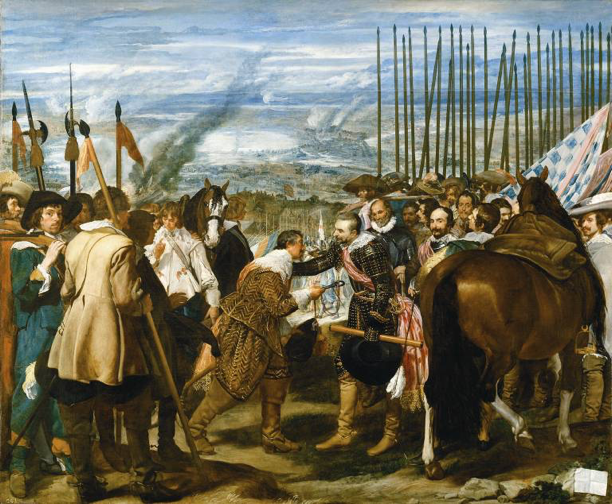
Surrender at Breda, Velázquez 1634-1635
We see a very different, more severe style of painting in Spain. The still life paintings are austere and dramatic. While the genre paintings and secular paintings encourage respect of elders, moments in everyday life, and the dignity of those less fortunate. Velázquez, who will become the Spanish court painter, has tremendous talent, and creates several intriguing paintings at this time. His early paintings are detailed and show his skill. Surrender at Breda, is a propaganda painting in support of the Spanish control of areas of the Netherlands. It is not an accurate history painting, although some of the individuals are accurately represented. War is brutal, and the animosity and hatred between the two sides is not addressed in the painting, it appears as two gentlemen greeting cordially.
He travels to Rome with a letter of introduction for the pope from the Spanish court. However, the pope refuses to see him, and he stays on in Rome and paints his companion, and fellow artist, Juan de Pareja. During his stay, he paints Juan and the painting is well received in Rome. The darkened background is unique. Velázquez observes that in life, if one focuses on the face, the background becomes blurred. He incorporates this in the painting. The lighting and pose are striking as well.
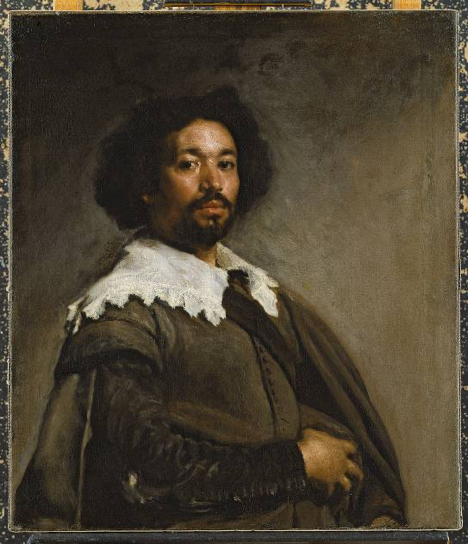
Juan de Pareja, Velázquez, 1650
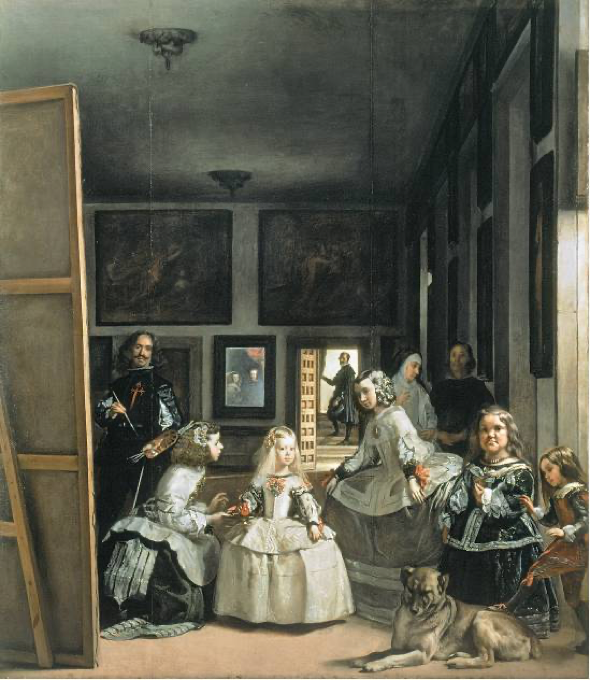
The Maids of Honor, Velázquez, 1656
The Maids of Honor shows Velázquez in his studio painting. The subject of the painting is unknown, but we are left to figure out this puzzle. We have several pairs of eyes looking back at us. The princess is the central figure, but we have several other intriguing people including the artist, and the king and queen in the mirror. It is his greatest painting where we become the viewer.
https://www.youtube.com/watch?v=qPsd9ZHY58E
https://www.youtube.com/watch?v=WKRKrpz09Fk
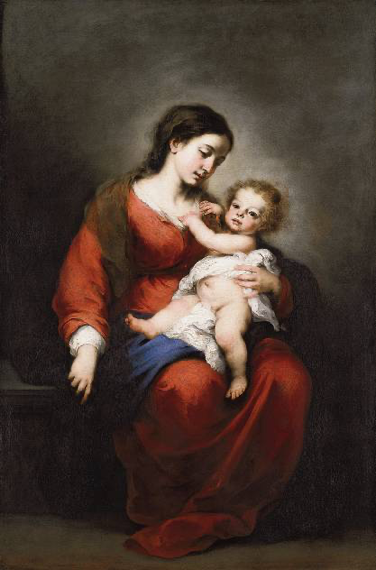
The Virgin and Child, Bartolomé Esteban Murillo 1675-1680
Bartolomé Esteban Murillo establishes a Counter Reformation image of the Virgin Mary and the child Jesus that will be copied repeatedly in the years to come. Mary is a relatable motherly figure showing great patience and affection towards her extremely cute child as he tugs on her dress.


